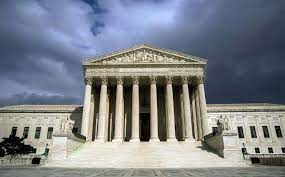A federal appeals court’s ruling was reversed to the relief of law enforcement throughout the country. The U.S. Supreme Court has overturned a “provocation rule” developed by the San Francisco-based 9th U.S. Circuit Court of Appeals that gave victims of police shootings an additional route to sue for alleged excessive force.
Justice Samuel Anthony Alito Jr. wrote the opinion for a unanimous court. Justice Neil M. Gorsuch didn’t participate in the case. The rule had held that police who use force not deemed excessive may be liable nonetheless because they provoked the victims to respond in a way that makes officers reasonably fear for their safety. Under the rule, the provocation had to be a separate Fourth Amendment violation.
In October 2010, Los Angeles police officers Christopher Conley and Jennifer Pederson received a call to assist in searching for a parolee, Ronnie O’Dell, who was believed to be armed and dangerous. The search led the two officers to the home of Paula Hughes, where O’Dell was last seen. As others searched the main house, Officers Conley and Pederson began searching the backyard, which contained a shack that was occupied by Angel Mendez and his wife. The officers were aware that Mendez and his wife lived in the shack in the rear of the property. Inside the shack, Mendez and his wife were sleeping. The officers did not have a warrant to search the shack nor did they knock and announce their presence. The officers opened the door to the shack, Mendez rose from the bed and was holding a BB gun, which he states he used for rodent control. Officer Conley yelled gun, and he and Officer Pederson opened fire, a total of 15 rounds. Mendez and his wife were shot multiple times suffering severe injuries, and O’Dell was not found on the property.
Following this incident Mendez and his wife filed a lawsuit against the police department and Officers Conley and Pederson. The lawsuit alleged excessive force and violations of the 4th Amendment for an unreasonable warrantless search. The lawsuit was filed in Federal District Court and the trial resulted in a verdict in favor of Mendez and his wife. The 9th Circuit Court of Appeals then heard the case and found that the officers were liable for the warrantless entry into the Mendez home and that the officers were liable for the shooting on the theory that they had intentionally and recklessly brought about the shooting by entering the shack without a warrant. The 9th Circuit Court called this the “provocation rule” which holds an officer liable if his or her actions provoked the violent situation and if his or her constitutional violation (here, the unlawful entry into the Mendez residence) proximately caused an injury.
The case ultimately ended up before the United States Supreme Court to decide whether or not the 9th Circuit Court’s decision under the “provocation rule” was constitutional. The Supreme Court noted that the “provocation rule” was only used by the 9th Circuit and heavily criticized in other circuits around the country. The Supreme Court has previously looked at police liability in Graham v. O’Connor and stated that a police officer’s use of force violates the Fourth Amendment only if it is objectively unreasonable under the facts and circumstances of each particular case. Officers often are forced to make quick decision under duress and are therefore judged under those circumstances. As a result, in more recent cases the Supreme Court has suggested that an officer’s actions before his or her use of force are not irrelevant to the reasonableness inquiry.
The Supreme Court held that the officers could not be held liable under the 9th Circuit’s “provocation rule” because such a rule was an unnecessary expansion of the Graham decision and no longer looked to the officers beliefs at the time of shooting. The Supreme Court noted that when accounting for the officers’ point of view at the time they confronted the weapon in Mendez’s pointed at them, the shooting was not unreasonable. By asking a court to “look back in time to see if there was a different Fourth Amendment violation that is somehow tied to the eventual use of force,” the Supreme Court reasoned, the 9th Circuit’s “novel and unsupported” rule “conflates distinct Fourth Amendment claims.” In determining the reasonableness of the officers’ use of force the Court is only to look at the circumstances immediately surrounding the shooting and not the events that led up to the shooting. Therefore, the officers’ warrantless entrance into the home is not material, and has no bearing on the officers’ liability in shooting someone they saw pointing a gun in their direction.
Alito noted that the provocation rule may be motivated by the notion that it is important to hold police officers liable for the foreseeable consequences of their constitutional torts. “However, there is no need to distort the excessive force inquiry in order to accomplish this objective,” Alito said. “To the contrary, both parties accept the principle that plaintiffs can—subject to qualified immunity—generally recover damages that are proximately caused by any Fourth Amendment violation.” Law enforcement has already been forced to fight with a hand tied behind its back. Thankfully the court prevented both hands from being restrained.


